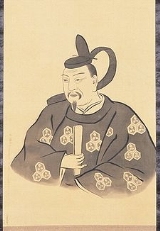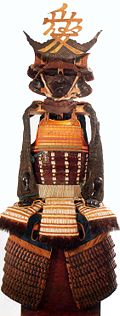
Naoe Kanetsugu
Encyclopedia

was a Japanese samurai
Samurai
is the term for the military nobility of pre-industrial Japan. According to translator William Scott Wilson: "In Chinese, the character 侍 was originally a verb meaning to wait upon or accompany a person in the upper ranks of society, and this is also true of the original term in Japanese, saburau...
of the 16th-17th centuries. The eldest son of Higuchi Kanetoyo, Kanetsugu was famed for his service to two generations of the Uesugi daimyo. He was also known by his court title, Yamashiro no Kami (山城守) or his childhood/adolescent name, Higuchi Kanetsugu (樋口 兼続).
Kanetsugu served first as a koshō (小姓)
Page (servant)
A page or page boy is a traditionally young male servant, a messenger at the service of a nobleman or royal.-The medieval page:In medieval times, a page was an attendant to a knight; an apprentice squire...
to Uesugi Kenshin
Uesugi Kenshin
was a daimyo who ruled Echigo province in the Sengoku period of Japan.He was one of the most powerful lords of the Sengoku period. While chiefly remembered for his prowess on the battlefield, Kenshin is also regarded as an extremely skillful administrator who fostered the growth of local industries...
. After Kenshin had died, he served Kagekatsu
Uesugi Kagekatsu
was a daimyo during the Sengoku and Edo periods of Japanese history. The son of Nagao Masakage and husband of Uesugi Kenshin's elder sister, Aya-Gozen. After his father died, he was adopted by Kenshin....
, of the adopted son of Kenshin. Kanetsugu's brother, Ōkuni Sanehiro, was also a famous Uesugi retainer.
Biography
Kanetsugu was born Higuchi Yoroku, at Sakato Castle in Echigo ProvinceEchigo Province
was an old province in north-central Japan, on the shores of the Sea of Japan. It was sometimes called , with Echizen and Etchū Provinces. Today the area is part of Niigata Prefecture, which also includes the island which was the old Sado Province. This province was the northernmost part of the...
. His father, Higuchi Sōemon Kanetoyo, was a senior retainer of Nagao Masakage
Nagao Masakage
was the head of the Ueda Nagao clan following the Sengoku period of the 16th century of Japan. Masakage was the brother-in-law of the famous Uesugi Kenshin, the "Dragon of Echigo". Masakage was the father of Uesugi Kagekatsu....
, the lord of Sakato Castle. When Yoroku came of age, he married Osen, the widow of Uesugi retainer Naoe Nobutsuna, and took the name Naoe Kanetsugu. He quickly distinguished himself as an outstanding commander, and was involved in much of the fighting that took place on the Sea of Japan
Sea of Japan
The Sea of Japan is a marginal sea of the western Pacific Ocean, between the Asian mainland, the Japanese archipelago and Sakhalin. It is bordered by Japan, North Korea, Russia and South Korea. Like the Mediterranean Sea, it has almost no tides due to its nearly complete enclosure from the Pacific...
coast with Sassa Narimasa
Sassa Narimasa
, also known as Kura-no-suke , was a Japanese samurai of the Sengoku through Azuchi-Momoyama period. He became a retainer of Oda Nobunaga in 1550 and was granted Etchū Province as a reward for helping Shibata Katsuie fight the Uesugi clan. After Nobunaga's death, in 1584 he joined Tokugawa Ieyasu...
and Maeda Toshiie
Maeda Toshiie
was one of the leading generals of Oda Nobunaga following the Sengoku period of the 16th century extending to the Azuchi-Momoyama period. His father was Maeda Toshimasa. He was the fourth of seven brothers. His childhood name was "Inuchiyo" . His preferred weapon was a yari and he was known as...
. Kanetsugu was also responsible for the actions of the Uesugi clan against the allies of the Tokugawa
Tokugawa clan
The was a powerful daimyo family of Japan. They nominally descended from Emperor Seiwa and were a branch of the Minamoto clan by the Nitta clan. However, the early history of this clan remains a mystery.-History:...
during the leadup to the climactic Battle of Sekigahara
Battle of Sekigahara
The , popularly known as the , was a decisive battle on October 21, 1600 which cleared the path to the Shogunate for Tokugawa Ieyasu...
. Following the Uesugi clan's surrender to the Tokugawa, in 1601, their holdings were transferred to the much smaller fief of Yonezawa, with an income of 60,000 koku
Koku
The is a Japanese unit of volume, equal to ten cubic shaku. In this definition, 3.5937 koku equal one cubic metre, i.e. 1 koku is approximately 278.3 litres. The koku was originally defined as a quantity of rice, historically defined as enough rice to feed one person for one year...
. Kanetsugu was granted a stipend shortly before he retired.
After death
Following his death, his wife Lady Osen (お船), per the custom at the time, took the tonsure, cutting her hair short and becoming a Buddhist nun. She was renamed Lady Teishin-ni (貞心尼). Teishin-ni helped rear the young Uesugi heir, Uesugi Sadakatsu, eventually dying in 1637 at the age of 81.Personality
Naoe Kanetsugu was respected for his judgment. In "The Life of Toyotomi Hideyoshi," Walter and M.E. Dening recount an anecdote in which Hideyoshi, whose temporary unification of Japan paved the way for Ieyasu's shogunate, decides to visit Uesugi Kagekatsu, Kanetsugu's liege lord at the time, in person, accompanied by just a few retainers.On receipt of the news, Kagekatsu called a council to discuss what was best to do under the circumstances. The majority of the councilors advised the assassination of Hideyoshi, arguing that this was by far the simplest way of ridding themselves of a dangerous enemy. But Naoe Kanetsugu condemned this advice as unworthy of a man holding the position of Kagekatsu. "Hideyoshi's coming among us unguarded," said Kanetsugu, "is proof of his profound respect for our master. With lesser personages Hideyoshi would not so expose himself to danger. Knowing that our lord is a man of noble disposition, he trusts himself among us. Were we take advantage of this and slay him, the story of our baseness and treachery would be handed down to distant posterity to our eternal shame. No: let our master meet magnanimity with magnanimity; let him have an audience with Hideyoshi and let them see whether they cannot come to an understanding. If they cannot agree, then we will fight, but not till Hideyoshi has been sent back to his own country."
In popular culture
The 2009 48th NHK Taiga drama TenchijinTenchijin
is the 48th NHK Taiga drama. It airs on NHK from January 4, 2009 every Sunday from 20:00 to 20:44 JST to November 22, 2009 spanning 47 episodes. The story centers on the life of the 16th century samurai Naoe Kanetsugu....
was a dramatization of his life.
See People of the Sengoku period in popular culture.
External links
- "TEN-CHI-JIN" General of UESUGI Clan NAOE KANETSUGU - (Japanese)-Kabuto(Samurai Helmet) Papercraft

